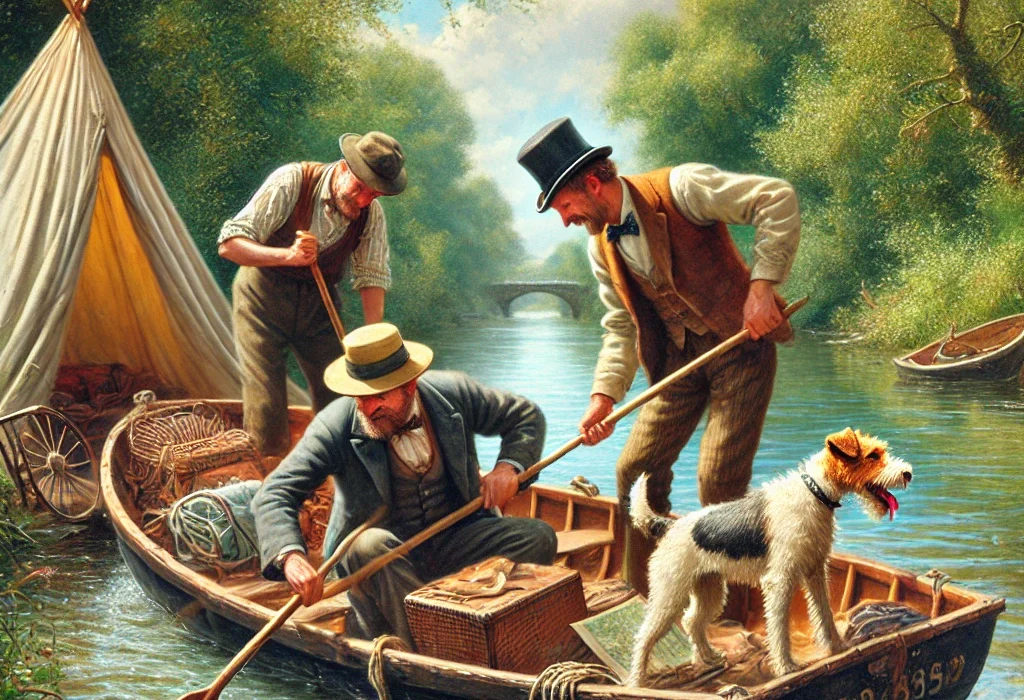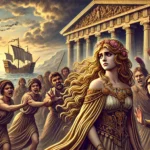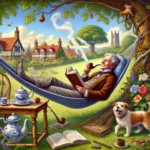“Three Men in a Boat (To Say Nothing of the Dog)” by Jerome K. Jerome is a humorous travelogue first published in 1889. The novel follows three friends—Jerome (the narrator), George, and Harris—and their dog, Montmorency, as they embark on a boating holiday along the Thames River. The narrative blends the comedic misadventures of their journey with satirical observations on life, health, and society.
Plot Summary
The tale begins with three friends—J., George, and Harris—sitting in J.’s room, lamenting their supposed ill health. Each man is convinced he suffers from a host of maladies. J., in particular, is prone to hypochondria, imagining he has every disease described in medical advertisements. The trio agrees they need a break from their stressful lives to recover and rejuvenate. After considering various options, including a sea voyage, they decide on a boating trip along the Thames. The fourth member of their group, Montmorency the dog, isn’t thrilled about the idea but is outvoted.
They plan the trip meticulously, or at least they try to. Their attempts at organizing and packing are plagued with comical mishaps. J. takes pride in his packing skills, only to realize he’s forgotten essential items like his toothbrush. George and Harris’s attempts are no better; they end up breaking and misplacing things, and Montmorency manages to get in the way, adding to the chaos. After much trial and error, they finally manage to get their gear in order and set off on their adventure.
The journey begins at Kingston, and right from the start, it is clear that things are not going to go as smoothly as they hoped. The trio encounters numerous obstacles, starting with the simple act of navigating the boat. None of them are particularly skilled at rowing, and their attempts to do so are hilariously inept. They argue over who should row and who should steer, and at times, they find themselves going in circles or crashing into riverbanks. Yet, despite their clumsiness, there’s a certain joy and camaraderie in their efforts.
As they travel upriver, they encounter the picturesque English countryside, which J. describes with poetic admiration. However, these moments of tranquility are short-lived, often interrupted by their humorous misadventures. Setting up camp proves to be another challenge. The simple task of putting up a tent becomes a test of patience as the men struggle with poles and ropes, all while Montmorency does his best to sabotage their efforts. When they finally settle down to eat, they realize they’ve forgotten some essential items, leading to improvisation and laughter.
Their interactions with the locals add another layer of humor to their journey. They encounter a host of characters, each more eccentric than the last. In one memorable incident, they visit a pub and become embroiled in a debate about the pronunciation of a local town’s name. The locals’ passionate and contradictory opinions only add to the confusion, and the friends leave none the wiser.
One evening, they decide to cook an Irish stew, throwing in whatever they have on hand. The result is a concoction that defies description but somehow turns out to be delicious. Montmorency contributes a dead water rat to the mix, which they thankfully decline. The cooking episode encapsulates the spirit of their journey—improvised, chaotic, but ultimately satisfying.
Despite their incompetence, there are moments of genuine beauty and reflection. J. often breaks into musings about the river’s history, imagining the scenes it has witnessed over the centuries. These contemplative moments provide a stark contrast to the trio’s often bumbling antics, highlighting the timeless allure of the Thames and the English landscape.
Weather is another constant challenge. On one occasion, they face a sudden downpour while camping. The rain turns their tent into a soggy mess, and they end up drenched and miserable. Seeking refuge in an inn, they experience the comfort of a warm meal and a dry bed, reminding them of the simple pleasures of life that are often taken for granted. The unpredictable English weather keeps them on their toes, adding an element of unpredictability to their adventure.
As they continue, their initial enthusiasm for the trip begins to wane. The river, which seemed so idyllic at first, now feels like a series of endless bends and backbreaking rowing. Harris, in particular, becomes increasingly irritable, often voicing his frustration with their lack of progress. George, who initially suggested the river trip, becomes the target of their grievances, though he takes it all in good humor.
One of the most humorous incidents involves a visit to the Hampton Court Maze. Confidently entering the maze, the friends soon find themselves hopelessly lost. Their attempts to navigate out become increasingly frantic and futile, as they repeatedly encounter the same dead ends. Their pride wounded, they finally have to be rescued by the keeper, who guides them out with practiced ease. This episode serves as a metaphor for their entire journey—well-intentioned but often ending in confusion.
Despite their trials, the trio shares moments of genuine friendship and laughter. They reminisce about past adventures, swap stories, and poke fun at each other’s quirks. Even Montmorency, with his mischievous antics, becomes an integral part of their camaraderie, providing a source of endless amusement and occasional exasperation.
As their journey nears its end, they reach Oxford, a city rich in history and beauty. However, by this point, they are thoroughly exhausted and have had their fill of river life. The thought of rowing back to London fills them with dread, and they unanimously decide to take the train home. This decision, made with a mix of relief and satisfaction, marks the end of their adventure on the Thames.
Back in London, they look back on their trip with a sense of accomplishment and nostalgia. Despite the challenges and mishaps, the journey has brought them closer together and given them memories to last a lifetime. They realize that the real joy lay not in the destination, but in the shared experience of the journey itself.
Main Characters
Jerome (J.): The narrator and the central figure of the story. He is prone to hypochondria and often imagines himself suffering from a range of ailments. His observations and witty asides drive much of the humor in the novel.
George: A friend of Jerome’s, who works at a bank. He is pragmatic, a bit lazy, and often the voice of reason among the three. George suggests the river trip as a remedy for their various imagined illnesses.
Harris (William Samuel Harris): Another friend on the trip, Harris is portrayed as being a bit bumbling and clueless, particularly when it comes to practical tasks. He often contrasts with Jerome’s idealism and George’s pragmatism.
Montmorency: The dog, who provides comic relief throughout the novel. He is described as a fox-terrier and has a mischievous nature, often causing chaos during the trip.
Theme
The Absurdity of Human Nature: Jerome humorously highlights the folly and eccentricities of people, particularly through the friends’ interactions and misadventures. The way they overcomplicate simple tasks and the narrator’s hypochondria are prime examples.
The Idleness of the Middle Class: The novel satirizes the leisurely lifestyle of the Victorian middle class, who, despite having relatively easy lives, often complain about being overworked and stressed.
Nature and the Pastoral Life: Jerome contrasts the chaotic life in the city with the supposed tranquility of the countryside. However, the trio’s experience reveals that the pastoral life is not always as idyllic as they imagined.
Comradeship and Friendship: Despite the frequent squabbles and frustrations, the bond between the three friends is a central theme. Their camaraderie and mutual support underscore the importance of friendship.
Writing Style and Tone
Jerome K. Jerome’s writing is characterized by a light, humorous tone that blends wit and irony. His style is conversational, often directly addressing the reader, which creates an intimate and engaging narrative. The humor is both situational and observational, with Jerome’s sharp eye for the absurdities of everyday life. The narrative is filled with digressions and anecdotes, which add to the book’s charm and humor. Jerome also employs a certain level of exaggeration and hyperbole, particularly when describing the characters’ ailments and misadventures, enhancing the comedic effect.
We hope this summary has sparked your interest and would appreciate you following Celsius 233 on social media:
There’s a treasure trove of other fascinating book summaries waiting for you. Check out our collection of stories that inspire, thrill, and provoke thought, just like this one by checking out the Book Shelf or the Library
Remember, while our summaries capture the essence, they can never replace the full experience of reading the book. If this summary intrigued you, consider diving into the complete story – buy the book and immerse yourself in the author’s original work.
If you want to request a book summary, click here.
When Saurabh is not working/watching football/reading books/traveling, you can reach him via Twitter/X, LinkedIn, or Threads
Restart reading!








